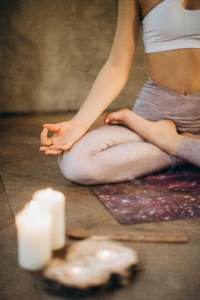Introduction: The Constant Need to Do Something
I don’t know how to slow down, how to stop and find peace. If I’m washing dishes, I have the TV on. If I’m walking the dog, I’m listening to a podcast. When I’m packing lunches for my son, YouTube is playing in the background. Even when I lie down at night, my thoughts are racing from one task to the next. There is never a moment where I’m just in it — fully present with one thing at a time.
Over time, this way of living led to something I didn’t expect: I started crashing out. Not burnout in the dramatic sense, but more like moments where I just couldn’t function. I’d sit on the couch with the intent to relax and feel nothing but guilt. I’d walk into a room and forget why I went in. I was overloaded. Always stimulated. Never still. That’s when I knew something needed to change. In this post, I want to share the steps I’m taking to stop, let my mind race without reacting, and slowly learn how to be more mindful.
Step 1: Name the Racing Mind
The first thing I had to do was admit it: my mind is constantly racing, and that’s not normal. I used to think this was just how I functioned best. But it turns out, multitasking everything wasn’t helping me get more done. It was draining my mental battery.
So I started labeling it.
“This is overstimulation.” “My brain is looking for noise.” “I feel anxious being still.”
Naming the feeling gave me power. I wasn’t broken. I was just running on autopilot.
Step 2: Let the Mind Race Without Fueling It
When I tried meditation, I thought I was doing it wrong because my thoughts didn’t stop.
Now I realize the goal isn’t to stop thoughts. It’s to observe them without piling on. So instead of grabbing my phone the moment silence creeps in, I let the thoughts run.
“I need to answer that email.” “What if I forget the milk?” “Should I be doing something right now?”
And I let them float by. Like clouds.
This takes practice, but the more I do it, the more I notice peace isn’t the absence of thought—it’s the absence of reaction.
Step 3: Reclaim One Task at a Time
I started small. Instead of walking the dog with a podcast, I just… walked the dog. I listened to my footsteps. Felt the breeze. Noticed the way the leash tugged when he got excited.
It wasn’t easy. I kept reaching for my phone. But slowly, the walk became a mental reset instead of just another productivity slot.
Pick one thing in your day and do it without a screen, without music, without multitasking.
Maybe it’s:
- Brushing your teeth
- Washing dishes
- Drinking your morning coffee
That’s where mindfulness starts—not in a yoga class or meditation retreat, but in the small things.
Step 4: Let Go of the Need to Always Be Doing
This one’s hard.
If you’re like me, you tie your worth to your productivity. But the truth is: rest is productive. Stillness has value.
When I started giving myself permission to do nothing, my anxiety didn’t vanish overnight—but I began to notice when I was full, when I needed a break, and when the crash was coming.
Mindful breaks are now part of my day. A few minutes of just sitting, breathing, or watching the trees sway outside.
That’s it.
Step 5: Create a Daily Check-In
Each evening, I ask myself:
- When did I feel overstimulated today?
- Did I slow down, even for a minute?
- What helped me feel grounded?
This practice isn’t about perfection. It’s about awareness. And with awareness, I can course-correct before I hit the wall.
Final Thoughts: Finding Peace Is a Practice
If your mind won’t slow down, you’re not alone. Our world rewards the hustle and drowns out the stillness. But peace doesn’t come from doing more. It comes from being here.
One dish. One walk. One breath at a time.
You Might Also Like:
